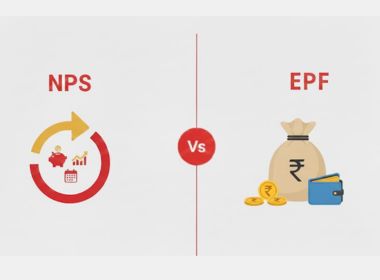Search Suggestions
- Gold Loan
- Money Transfer
- Mutual Funds

Smart Ways to Maximise Your Savings with NPS Tax Benefits
Anyone earning income above a certain threshold in Indian has to pay income tax. However, there are ways through which one can reduce their tax liabilities. One such way is investing in the National Pension Scheme (NPS).
Table of Content
Simply put, the NPS scheme is a retirement plan that encourages you to put some money into a pension account regularly during your working life, ensuring a steady monthly income once you retire. The government offers many tax benefits on NPS, allowing you to not only secure your future but also save on taxes.
Breakdown of Tax Benefits Under NPS
Here is a comprehensive breakdown of NPS tax benefits for salaried employees, as well as self-employed individuals:
NPS Tax Benefits for Salaried Employees Under the Old Regime
- Up to Rs. 1.5 Lakh under Section 80CCD(1)
Under this section, salaried individuals can claim a deduction of up to 10% of their salary (basic + dearness allowance). The maximum deduction under this section is ₹1.5 lakh per year.
- 50,000 under Section 80CCD(1B)
Under this section, you can claim an additional deduction of up to ₹50,000 for contributions made to NPS beyond the ₹1.5 lakh limit under Section 80CCD(1).
- Employer’s Contribution under Section 80CCD(2)
Under this section, a private sector employee can claim a deduction of 10% of their basic salary, whereas a central government employee can claim 14% their salary (basic + DA) as a deduction.
Overall, if you are a private sector employee with a basic salary and DA of Rs. 10 lakh, you can claim up to Rs. 1 lakh under Section 80CCD(1), Rs. 50,000 under Section 80CCD (1B), and Rs. 1 lakh under Section 80CCD (2) under the old regime. The total deduction will be of Rs. 2.5 lakh.
On the other hand, if you are a central government employee with a basic salary and DA of Rs. 10 lakh, you can claim up to Rs. 1 lakh under Section 80CCD(1), Rs. 50,000 under Section 80CCD (1B), and Rs. 1.4 lakh under Section 80CCD (2) under the old regime. The total deduction will be of Rs. 2.9 lakh.
Suggested Blog: NPS Scheme Details: Everything You Need to Know About This Retirement Plan
NPS Tax Benefits for Salaried Employees Under the New Regime
If you pay your taxes under the new regime, you won’t be eligible for Section 80CCD(1) and Section 80CCD(1B) deductions. However, you are still eligible for the NPA benefit in the new tax regime under Section 80CCD(2).
This means that private sector employees can claim a 10% deduction of their salary (basic + DA), while central government employees can claim a 14% deduction.
For Self-Employed Individuals
Self-employed individuals can also enjoy the NPS tax benefits. They can claim a deduction under two schemes, including:
- Up to Rs. 1.5 lakh under Section 80CCD(1)
Under this section, self-employed individuals can claim a deduction of up to 20% of their gross total income, subject to the overall limit of ₹1.5 lakh under the combined Section 80CCE.
- Up to Rs. 50,000 under Section 80CCD(1B)
Under this section, self-employed individuals are allowed an extra deduction of up to ₹50,000.
Tax Treatment on Withdrawal & Annuity
- Taxation at Retirement (Age 60+)
At retirement or age 60, you will be able to withdraw up to 60% of the total accumulated corpus as a lump sum. This amount is tax-free under Section 10(12A) of the Income Tax Act. The remaining 40% of the corpus must be invested in an annuity plan to provide a regular pension, which is taxed as per your income tax slab.
For example, if your NPS corpus is 50 lakhs at the time of retirement, you can withdraw ₹30 lakh tax-free, while the remaining ₹20 lakh is invested in an annuity and will be taxable.
- Taxation on Premature Withdrawal
In case you withdraw your NPS before retirement (60 years), only 20% of the corpus will be available for tax-free withdrawal. The remaining amount will be used for annuity purchase.
Suggested Blog: How to Invest in NPS: Step-by-Step Guide for Beginners
Tax Benefits in NPS Vatsalya
The NPS Vatsalya Scheme offers special tax benefits for parents or guardians investing for their minor children. Key tax benefits in NPS Vatsalya are:
- An additional deduction of up to ₹50,000 per financial year under Section 80CCD(1B) of the Income Tax Act, over and above the ₹1.5 lakh limit under Section 80C.
- This allows a total deduction of up to ₹2 lakh when combined.
- This additional tax benefit applies under both the old and new tax regimes.
Strategies to Maximise Tax Benefits with NPS
- Start Early: Begin investing in NPS as soon as possible. The earlier you invest, the higher your returns and tax savings.
- Optimise Employer Contributions: If your employer offers an NPS scheme, opt for a higher contribution. It not only grows your retirement corpus but also helps reduce your taxable income.
- Leverage Section 80CCD (1B): Make sure to claim the additional ₹50,000 deduction available under this section to maximise your total tax benefit.
- Plan Withdrawals Smartly: Make sure you withdraw the NPS amount on retirement (60 years) to take advantage of the 60% tax-free withdrawal limit.
In conclusion, the National Pension Scheme (NPS) is one of the best ways to save on taxes while building a secure retirement fund. By using NPS tax benefits under Sections 80CCD(1), 80CCD(1B), and 80CCD(2), you reduce your taxable income and grow your savings over time. To further strengthen your financial portfolio, you can also invest in mutual funds alongside the NPS investments.
Muthoot Finance is a registered Point of Presence (POP) and has a vast network of branches across India, allowing investors to conveniently open and manage their NPS accounts.
- Invest in Mutual Fund
- Systematic Investment Plan
- Mutual Fund Calculator
- Liquid Mutual Fund
- Debt Funds
- Balanced Funds
- Equity Linked Schemes
- Tax Saving Schemes
CATEGORIES
OUR SERVICES
-

Gold Loan
-

Personal Loan
-

Cibil Score
-

Vehicle Loan
-

Small Business Loan
-

Money Transfer
-

Insurance
-

Mutual Funds
-

SME Loan
-

Corporate Loan
-

NCD
-

PAN Card
-

NPS
-

Custom Offers
-

Digital & Cashless
-

Milligram Rewards
-

Bank Mapping
-

Housing Finance
-

#Big Business Loan
-

#Gold Loan Mela
-

#Kholiye Khushiyon Ki Tijori
-

#Gold Loan At Home
-

#Sunherisoch
RECENT POSTS

Gilt Fund vs Liquid Fund: Full Form, Meaning & SIP Guide
Know More
XIRR in Mutual Funds & SIP: Full Form, Meaning, Formula and How to Calculate
Know More
7 Key Factors to Consider Before Taking an SME Loan
Know More
Difference Between Black Gold and Gold: Everything You Need to Know
Know More
NPS vs EPF: Everything You Need to Know About Retirement Savings
Know More
What is a Credit History? Impact on Credit Score and Credit Report
Know More
Loan Closure Vs. Loan Settlement: Meaning, Benefits, and CIBIL Score Impact
Know More
Is Silver the New Gold? A Look at 2025 Price Trends
Know More
What Are the Various Types of Equity Funds and How They Work?
Know More
Why Are Gold Loans Becoming the Most Preferred Financial Option in 2025?
Know MoreFIN SHORTS

What Are Co-Pay and Deductibles in Insurance Policies?
Know More
Should You Take a Loan Against Your Mutual Fund or SIP?
Know More
Top 5 Best Mid-Cap Mutual Funds to Watch in 2026
Know More
Are Personal Loans Right for Retirees? Key Points to Consider
Know More
What Happens to a Personal Loan After the Borrower Dies?
Know More
Best Loan Choices for Credit Scores of 580 and Below
Know More
7 Reasons Why a Gold Loan Is the Best Option for Small Businesses
Know More
10 Reasons Why People in India Prefer Physical Gold
Know More
Real Estate vs Gold: Which Is a Better Investment in India?
Know More
10 Common Mistakes That Make Investors Lose Money in Mutual Funds
Know More
10 Reasons Why Gold Has So Much Appeal in Uncertain Times
Know More
7 Ways Settling Debt Can Impact Your CIBIL Score
Know More- South +91 99469 01212
- North 1800 313 1212


